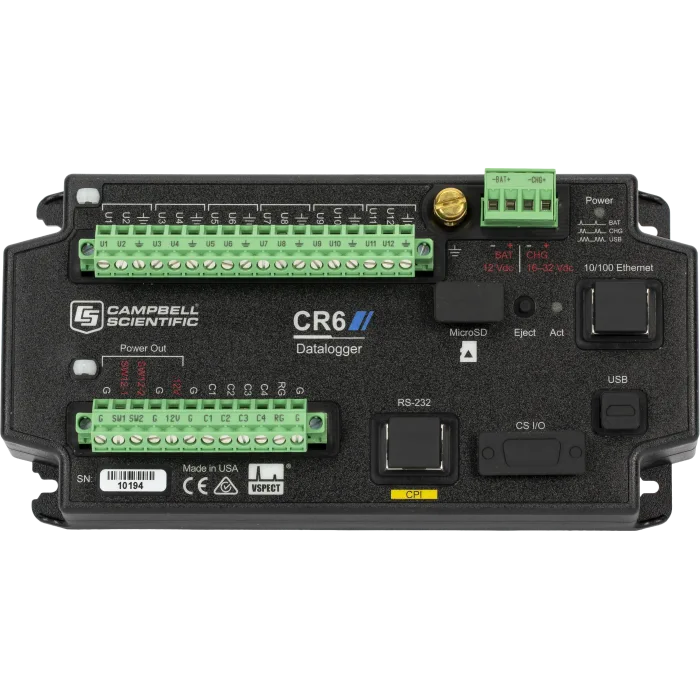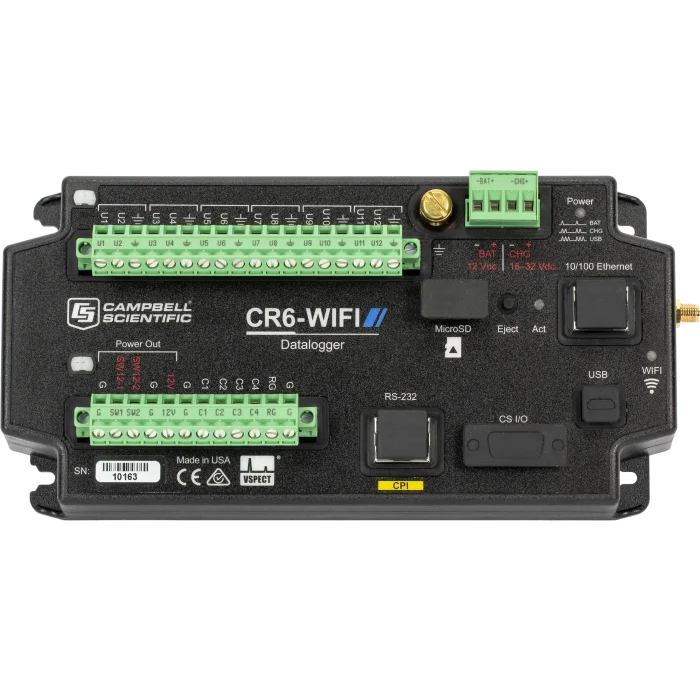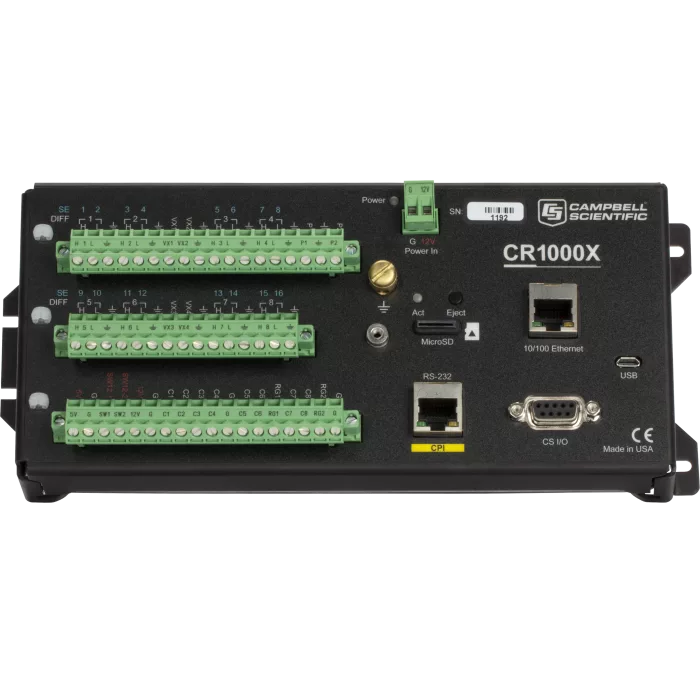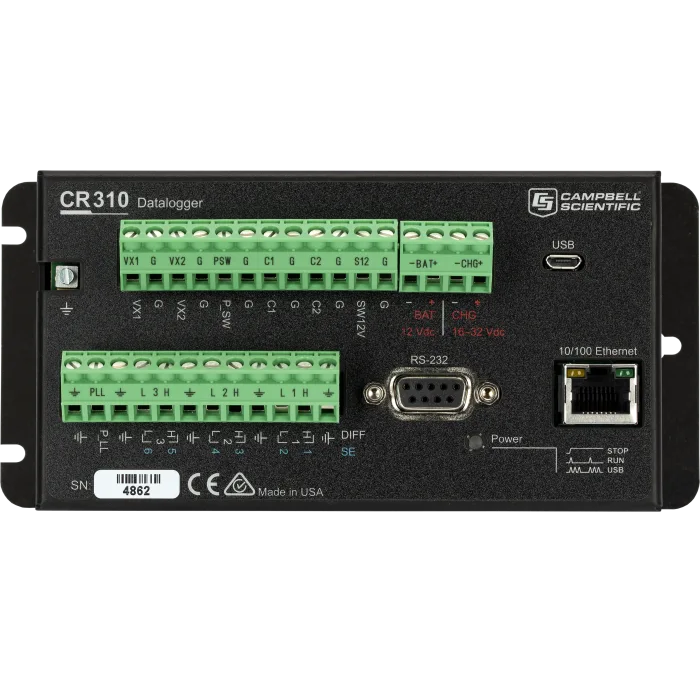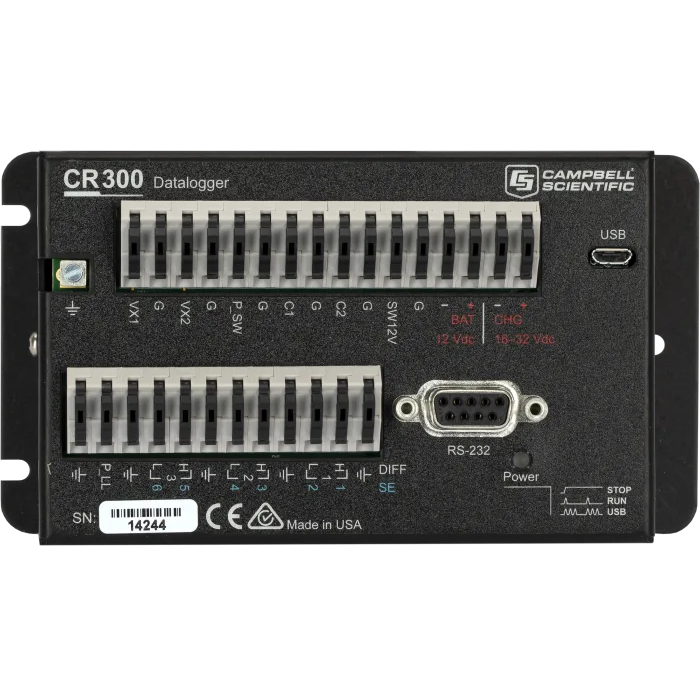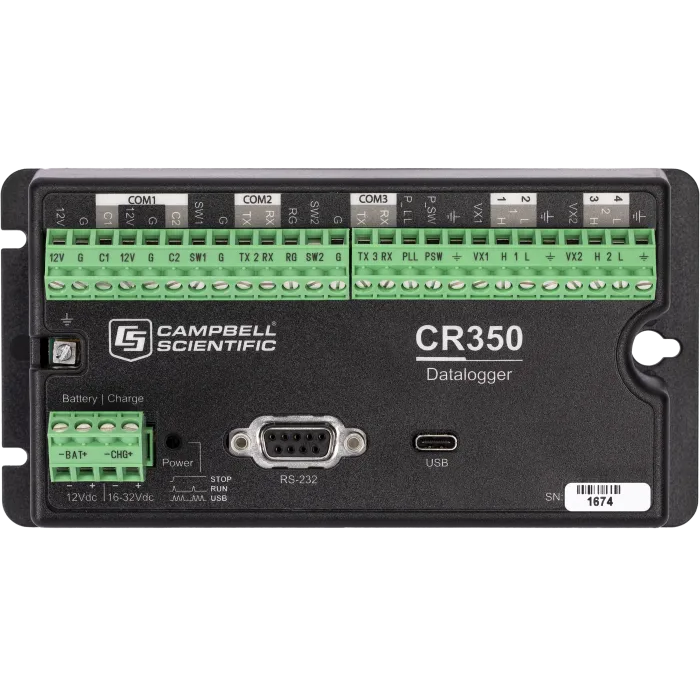Campbell Scientific: CR6 Datalogger
Veldig robust, fleksibel og pålitelig datalogger, egnet for vitenskapelige applikasjoner og alle typer feltstasjoner.
Overview
The CR6 Automated Monitoring Platform, designed on decades of infrastructure and environmental monitoring experience, is used by some of the largest monitoring networks worldwide. With the unique ability to serve both as an edge device and gateway, this simplifies networks that would otherwise require discrete devices to provide complete access to your data.
This unique platform is used where reliability, flexibility, and compatibility are essential to your success. The CR6 ecosystem supports an array of powerful peripherals that add channel capacity, distributed measurements, and communication capabilities, as well as measure vibrating wire sensors dynamically.
Campbell Scientific’s vibrating wire measurement devices, including the CR6, are the only devices that use patented VSPECT® technology. VSPECT filters external noise from your sensor and gives you diagnostic information about the quality of your vibrating wire measurement.
Learn about our patented VSPECT at our VSPECT® Essentials web resource.
The dynamic vibrating wire measurement technique is protected under U.S. Patent No. 8,671,758, and the vibrating wire spectral-analysis technology (VSPECT) is protected under U.S. Patent No. 7,779,690.
Benefits and Features
- All-in-one edge device and gateway with built-in connectivity
- Native vibrating wire measurements using VSPECT
- Integrated communication options, charge regulator, and expandable storage to provide simplicity and reduced costs
- Configurable Universal (U) measurement and control terminals to measure virtually any sensor or application
- Availability of Campbell Scientific qualified support staff
- Designed and manufactured for long-term operation in extreme environments
Spesifikasjoner
| -NOTE- |
|
| Operating Temperature Range |
|
| Maximum Scan Rate | 1000 Hz |
| Case Material | High-impact-resistant polycarbonate and UV-resistant TPE, recycle code 7 |
| Analog Inputs | Up to 12 single-ended or 6 differential (The CR6 has 12 universal [U] and 4 control [C] terminals that can be programmed for a variety of functions. The number of analog inputs, switched excitations, and digital ports assume all the ports are configured the same.) |
| Universal Inputs | 12 individually configured inputs for analog or digital functions |
| Pulse Counters | 16 (C1 to C4 and U1 to U12) |
| Communications Ports |
|
| Data Storage Ports | microSD |
| Switched 12 Volt | 2 terminals |
| Digital I/O | 16 terminals (C1 to C4, U1 to U12) configurable for digital input and output. Terminals are configurable in pairs for 5 V or 3.3 V logic for some functions. |
| Input Limits | ±5 V |
| Analog Voltage Accuracy |
|
| ADC | 24-bit |
| Power Requirements |
|
| Real-Time Clock Accuracy | ±3 min. per year (optional GPS correction to ±10 µs) |
| Internet Protocols | Ethernet, PPP, RNDIS, ICMP/Ping, Auto-IP (APIPA), IPv4, IPv6, UDP, TCP, TLS (v1.2), DNS, DHCP, SLAAC, Telnet, HTTP(S), SFTP, FTP(S), POP3/TLS, NTP, SMTP/TLS, SNMPv3, CS I/O IP, MQTT |
| Communication Protocols | CPI, PakBus, SDM, SDI-12, Modbus, TCP, DNP3, UDP, NTCIP, NMEA 0183, I2C, SPI, and others |
| Battery-backed SRAM for CPU Usage & Final Storage | 4 MB |
| Data Storage | 4 MB SRAM + 72 MB flash (Storage expansion of up to 16 GB with removable microSD flash memory card.) |
| Idle Current Drain, Average |
|
| Active Current Drain, Average |
|
| Static Vibrating Wire Measurements | Supported |
| Dimensions | 21.0 x 10.2 x 5.6 cm (8.3 x 4.0 x 2.2 in.) Additional clearance required for cables and leads. |
| Weight | 0.42 to 0.52 kg (0.92 to 1.15 lb) depending on communication option selected |
CR6-RF407 Option |
|
| Radio Type | Frequency Hopping Spread Spectrum (FHSS) |
| Output Power | 5 to 250 mW (user-selectable) |
| Frequency | 902 to 928 MHz (US, Canada) |
| RF Data Rate | 200 kbps |
| Receive Sensitivity | -101 dBm |
| Antenna Connector | RPSMA (External antenna required; see www.campbellsci.com/order/rf407 for Campbell Scientific antennas.) |
| Idle Current Drain, Average | 12 mA (@ 12 Vdc) |
| Active Current Drain, Average | < 80 mA (@ 12 Vdc) |
CR6-RF412 Option |
|
| Radio Type | Frequency Hopping Spread Spectrum (FHSS) |
| Output Power | 5 to 250 mW (user-selectable) |
| Frequency | 915 to 928 MHz (Australia, New Zealand) |
| RF Data Rate | 200 kbps |
| Receive Sensitivity | -101 dBm |
| Antenna Connector | RPSMA (External antenna required; see www.campbellsci.com/order/rf412 for Campbell Scientific antennas.) |
| Idle Current Drain, Average | 12 mA (@ 12 Vdc) |
| Active Current Drain, Average | < 80 mA (@ 12 Vdc) |
CR6-RF422 Option |
|
| Radio Type | Frequency Hopping Spread Spectrum (FHSS) |
| Output Power | 2 to 25 mW (user-selectable) |
| Frequency | 863 to 870 MHz (European Union) |
| RF Data Rate | 10 kbps |
| Receive Sensitivity | -106 dBm |
| Antenna Connector | RPSMA (External antenna required; see www.campbellsci.com/order/rf422 for Campbell Scientific antennas.) |
| Idle Current Drain, Average | 9.5 mA |
| Active Current Drain, Average | 20 mA |
CR6-RF427 Option |
|
| Radio Type | Frequency Hopping Spread Spectrum (FHSS) |
| Output Power | 5 to 250 mW (user-selectable) |
| Frequency | 902 to 907.5 MHz/915 to 928 MHz (Brazil) |
| RF Data Rate | 200 kbps |
| Receive Sensitivity | –101 dBm |
| Antenna Connector | RPSMA (External antenna required.) |
| Idle Current Drain, Average | 12 mA (@ 12 Vdc) |
| Active Current Drain, Average | < 80 mA (@ 12 Vdc) |
CR6-RF452 Option |
|
| Radio Type | Frequency Hopping Spread Spectrum (FHSS) |
| Output Power | 10 to 1,000 mW (user-selectable) |
| Frequency | 902 to 928 MHz |
| RF Data Rate | 115.2 or 153.6 kbps (selectable speeds) |
| Receiver Sensitivity |
|
| RF Connector | Reverse Polarity SMA (RPSMA) jack (external antenna required) |
| Idle Current Drain, Average | 15 mA (@ 12 Vdc) |
| Active Current Drain, Average | 650 mA (@ 12 Vdc) |
CR6-WIFI Option |
|
| Operational Modes | Client or Access Point |
| Operating Frequency | 2.4 GHz, 20 MHz bandwidth |
| Antenna Connector | RPSMA |
| Antenna | pn 16005 unity gain (0 dBd), 1/2 wave whip, omnidirectional with articulating knuckle joint for vertical or horizontal orientation |
| Transmit Power | 7 to 18 dBm (5 to 63 mW) |
Technical description
The CR6 is the only monitoring platform currently available that operates as an edge device and gateway with connectivity, provides an industry standard for rugged design, has universal sensor compatibility and communication options, and includes VSPECT for vibrating wire measurements.
Edge and Gateway Device
The variability and site-specific challenges and constraints that exist in robust monitoring networks typically result in a wide array of devices to achieve full functionality. With built-in and modular measurement, processing, control, and communication capabilities, the CR6 is the only device that is needed.
As a gateway device, the CR6 converts the data measured into the format or protocol required to seamlessly communicate on your network—whether on your computer or the cloud. Entry into the network does not require a separate edge device, as the CR6 also fills this role. Additionally, the CR6 forms a network as a connectivity device via spread-spectrum radio, Wi-Fi, serial, and RS-485.
Using the CR6 as an edge device and gateway with connectivity allows you to standardize on a single platform in your monitoring program. This simplifies purchasing, inventory management, and an overall required knowledge base. The CR6 is capable of a wide range of over thirty-five M2M protocols that include PakBus, MQTT, DNP3, IPv4, IPv6, HTTP/HTTPS, and PPP. Connectivity options include cellular, radio, satellite, Ethernet, and Wi-Fi. These communication methods enable access to critical data and the ability to receive alarms triggered by user-configured thresholds and events.
Native Vibrating Wire Using VSPECT
VSPECT, Campbell Scientific’s patented technology for measuring vibrating wire sensors, significantly improves vibrating wire sensor measurements—regardless of the manufacturer of the sensor. For more details about this unique technology visit our VSPECT® Essentials web resource.
Integrated Benefits for Simplicity and Reduced Costs
The integrated benefits and capabilities of the CR6 make it the most flexible platform available. In addition to several spread-spectrum radio options that are compatible with available frequencies across the world, it also includes Wi-Fi, Ethernet, and compatibility with modular cellular and satellite modems. Using Campbell Scientific communication peripherals ensures complete compatibility and extremely low power consumption.
The built-in charge regulator, with direct connections for main power or solar panels, is used to keep your battery charged. An intelligently designed and maintained power supply ensures long-term functionality and helps to capture data from critical events when you need it.
With regular data collection intervals or remote access, the 4 MB of onboard CR6 memory will likely be sufficient. However, if your application requires high measurement frequency; long, unattended deployments; or data storage redundancy, the CR6 has built-in expandable memory via a microSD card.
Communication Options
The CR6 Automated Monitoring Platform is available in different integrated communications frequency radio options.
CR6-WIFI
The CR6-WIFI comes factory-configured as a Wi-Fi access point. Alternatively, the CR6-WIFI can be configured to join an existing Wi-Fi
network with standard or Enterprise (EAP) security.
CR6-RF407
This 900 MHz, 250 mW, frequency-hopping spread-spectrum radio option can join a high-speed “mesh topology” radio network of other CR6s, ideal for medium-range, license-free radio communications.
CR6-RF412
Designed primarily for unlicensed operation in Australia and New Zealand, this 922 GHz, 250 mW, frequency-hopping spread-spectrum radio can join a high-speed “mesh topology” radio network of other CR6s and is also ideal for medium-range, license-free radio communications.
CR6-RF422
Used in the EU and ideal for short- to medium-range, license-free radio communications, this 868 MHz, 25 mW option includes listen-before-talk (LBT) and adaptive-frequency-agility (AFA). It can join a high-speed “mesh topology” radio network of other CR6s using the included RF422 radio.
CR6-RF452
With this internal 900 MHz, 1 W, frequency-hopping spread-spectrum radio option, the CR6-RF452 can be part of a “star topology” network where all radio-frequency (RF) traffic routes back through the gateway. This option is ideal for long-range, license-free radio communications.
Universal Measurement and Control Terminals
The Universal or “U” terminals allow each terminal to be configured to measure a multitude of different types of sensor outputs. This allows the CR6 to be used in many different applications, regardless of the sensor types required—analog, digital, smart, or vibrating wire. This nearly limitless array of sensors includes inclinometers, meteorologic, hydrologic, piezometers, water quality, etc. The flexibility of Universal channels allows you to standardize on a single monitoring platform for all projects.
Support Staff
Recognized for more than 45 years for our outstanding customer support, Campbell Scientific includes experienced product engineering teams, knowledgeable technical support, attentive sales staff, and market-focused professionals who are committed to ensuring your success throughout the lifetime of your project.
Rugged Design
Unique to all CR6 Automated Monitoring Platforms is the design and manufacturing process used to ensure operational integrity in the most extreme environments. Each CR6:
- Includes surge electrostatic discharge (ESD) and over voltage protection, as well as dust protection.
- Is fully tested for shock and vibration tolerance.
- Is factory chamber tested for its full operational temperature range (standard range -40° to +70°C and extended range -55° to +85°C).
- Has been proven in hundreds of real-world applications.
These extreme measures are required to manufacture a product with a meantime between failure (MTBF) of 557 years! This means that if you purchase a CR6 today, your probability of failures during the warranty period (three years) is 0.6%. The CR6 Automated Monitoring Platform will last the entirety of your project, even if that means decades.
Documentation
Brochures
- Vibrating-Wire Spectral Analysis Technology (VSPECT) (en)
- CR6 Specifications – 1156 (en)
- CR6 Datalogger (en)
Manuals
Technical Papers
